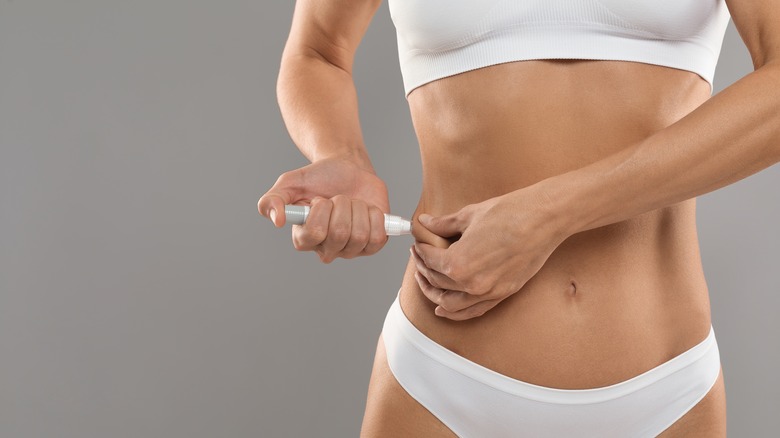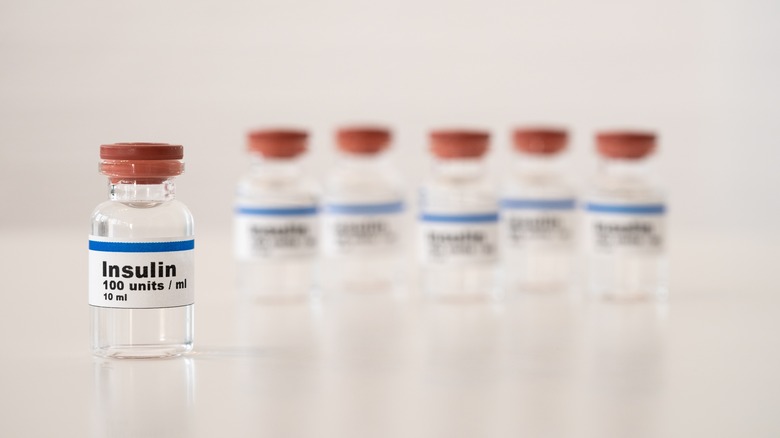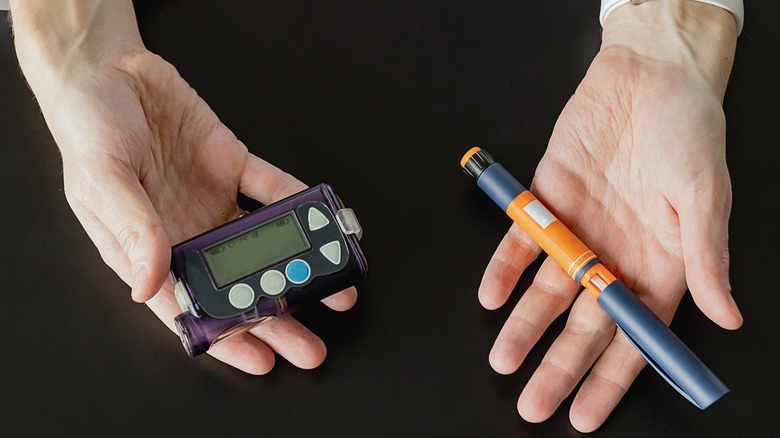This Is How Long It Takes For Insulin To Start Working
Insulin is an essential and naturally occurring hormone made by the pancreas. It transforms food into energy and controls your blood sugar levels (via the Cleveland Clinic). When the pancreas doesn't function properly, it might not release as much insulin as the body needs, usually resulting in what we know as diabetes, says the clinic. One in 10 out of 37.3 million Americans have diabetes, while over 96 million have prediabetes (via the Centers for Disease Control and Prevention (CDC). Despite these numbers, over 8 in 10 adults have no idea they have it, says the CDC.
According to Healthline, there are different types of diabetes — type 1 and 2. Type 1 is caused by an autoimmune disease. When you have this type, your body can't make insulin properly — since the insulin-producing cells in your pancreas have been harmed by your immune system (via Healthline). Although type 1 diabetes can develop in adulthood, it's more commonly diagnosed in younger people. Type 2 diabetes happens when your cells can't absorb sugar or glucose from the foods you consume, explains the Cleveland Clinic. If left untreated, it can lead to other health problems such as kidney diseases, heart diseases, and stroke, says the clinic.
If you have diabetes, you might be prescribed insulin since your body can't produce enough or is resistant to it (via Healthline). In this case, you might wonder how long it takes for insulin to start working.
How long does it take for insulin to start working?
The type your doctor prescribes will depend on your diabetes type and blood sugar level, says WebMD. According to American Family Physicians (AFP), there are various types of insulin, each working at different speeds. The quick-acting insulin, also known as insulin lispro (or Humalog), works very quickly, from 5 to 15 minutes, and can last for 3 to 4 hours. The short-acting (or Regular) insulin usually works within 30 minutes, lasting between 5 to 8 hours. The intermediate-acting (or Lente/NPH) insulin usually works within 1 to 3 hours, lasting 16 to 24 hours. Lastly, the long-acting (or Ultralente) insulin doesn't start to work for4 to6 hours, lasting between 24 and 28 hours, per American Family Physicians.
The behavior of insulin after administration can vary. Furthermore, the speed of absorption can differ for each person for reasons including the site of injection, the concentration of the insulin, and the frequency of injection site use (via Healthline). According to the Mayo Clinic, insulin isn't available in pill or tablet form because of a lower chance of proper absorption caused by the digestive system breaking it down before it can work. The source also mentions two major delivery options for insulin to work: the shot (pens) and the insulin pump.
How to take insulin
Insulin is typically injected under the skin with a tiny needle or an insulin pen, per the American Family Physicians (AFP). As advised by the source, it's important to first wash your hands and wipe the top of the insulin bottle with an alcohol-dipped cotton swab. Next, draw the correct insulin dose into the syringe by pulling back on the plunger. With your skin cleaned with alcohol-dipped cotton, grab a skin fold and inject the insulin at a 90-degree angle. You can inject insulin into your body via your stomach, thigh, and arm. While the area close to your stomach works fastest, insulin injected into your arm works at a medium speed but faster than the thigh, which takes a longer time to be absorbed (via AFP). According to WebMD, the different types of insulin have their own individual instructions concerning when to take them. For example, the extended-release pill might have to be taken the morning before you eat, while others can be taken during mealtime.
Besides causing a change in your blood sugar, some side effects of insulin include itching and swelling of the injected site, weight gain, constipation, and changes in the feel of your skin, says Medline Plus. More severe side effects that require immediate medical attention include wheezing, muscle cramps, a fast heartbeat, blurred vision, and difficulty swallowing.



